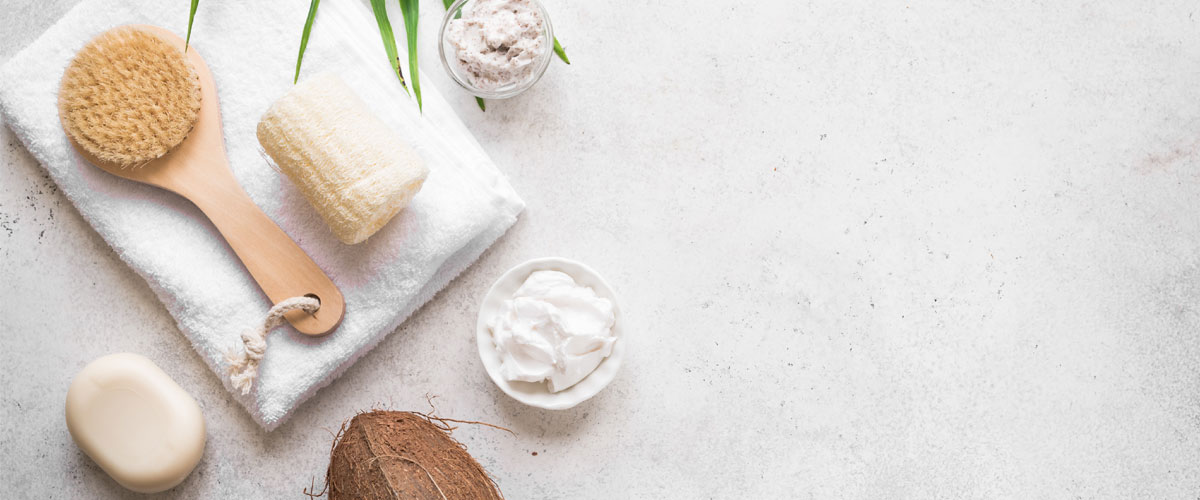Some 2050 years after her death, Cleopatra and her crew of ancient Egyptians are still considered to be beauty trailblazers, credited with inventing everything from kohl eyeliner to red lipstick and natural nail polish. According to legend, the queen’s penchant for taking a daily bath in donkey’s milk also made her an unwitting advocate for regular chemical exfoliation of the skin. Curious? We’ll explain how in a minute.
The term exfoliation simply means to slough away; in the skincare world, it refers to the removal of the cells that cling to the outermost layer of the skin’s surface (the stratum corneum). This process occurs naturally – older cells are constantly replaced with new ones that come up through the skin’s deeper layers – but sometimes, thanks to factors such as ageing, the process slows down. This can lead to skin cells hanging around past their welcome, which can make the skin look dull or flaky, and feel dry or rough to the touch. If the old cells become trapped in a hair follicle, it can result in blockages like pimples or blackheads.
Enter exfoliation, which gives nature a helping hand by getting rid of those pesky lingering skin cells. There are many different ways to exfoliate the skin, though they can generally be grouped into either chemical or physical forms.
Physical exfoliation
Also known as manual exfoliation or a scrub, it uses a type of abrasive to slough away the skin cells. But please don’t be misled by the terms “abrasive” and “scrub” – this should be a gentle process, not one that involves actual scrubbing or that leaves the skin red or raw! At its most basic, physical exfoliation can be done using a cloth, sponge or brush, or by using a natural substance such as sugar, salt, pumice, crushed seeds, nuts or husks. Small, smooth and non-abrasive beads are also effective, like the eco-friendly exfoliating beads in QV Face Exfoliating Polish.
The granular substance in an exfoliator is usually paired with a creamy or emollient base – such as an oil or paraffin – to provide some slip, minimise friction and help replenish the skin’s moisture. Manual exfoliators are usually massaged gently into the skin and then removed with water.
Chemical exfoliation
Chemical exfoliators are also a multifaceted bunch, encompassing both alpha-hydroxy acids (AHAs) and beta-hydroxy acids (BHAs), as well as enzymes derived from plants like pumpkin and papaya. Rather than scrubbing away old skin cells, chemical exfoliation works by gently dissolving the “glue” that binds cells, so they can release on their own1.
Remember Cleopatra’s donkey-milk baths? This is where they come in, as sour milk is a natural source of lactic acid, which is an AHA. If Cleo really was bathing in the stuff each day, she’d almost certainly be enjoying the skin-rejuvenating benefits of chemical exfoliation that AHAs are known for. Aside from lactic acid, other types of AHAs include glycolic acid (from sugar cane), citric acid (from citrus fruits), malic acid (from apples) and mandelic acid (from bitter almonds).
Depending on the formulation, a chemical exfoliator can be applied and removed quite quickly (as in a cleanser), or it may be designed to stay on the skin, if the ingredient is found in a serum or moisturiser.
Physical vs. chemical exfoliation - which is better?
When it comes to exfoliation, there’s no one-size-fits-all solution, as different formulas address different skin types and concerns, not to mention different parts of the body (what might be right for the thick skin on the soles of the feet could be too harsh for the more refined skin on the face).
By simply releasing old skin cells from the stratum corneum, all types of exfoliation can help skin to look smoother and more radiant. With different types of chemical exfoliation, glycolic acid has been found to be effective at removing superficial solar keratoses, those rough, scaly patches of skin caused by sun damage, and it can also improve the appearance of fine lines2. Glycolic and lactic acids have other benefits too: they’ve been found to rejuvenate sun-damaged skin, reducing the appearance of pigmentation and promoting the formation of new collagen3. Meanwhile, a BHA like salicylic acid can be beneficial for acne-prone skin, because it helps to keep pores clear4.
When is the best time to exfoliate the skin?
Again, the question of when and how often to exfoliate your skin depends on its condition, as well as the results you’re hoping to achieve. It’s recommended to use physical exfoliators on damp, clean skin, so they are often used immediately after cleansing. Chemical exfoliators can be included in a wide range of different skincare products, from cleansers to serums.
If you’re using an exfoliator for the first time, take it slow and steady, and start with one exfoliating product at a time. Exfoliating can make the skin more sensitive to the sun, so always use an SPF during the day. Follow the specific directions on each individual product and stop if irritation or redness occurs. AHAs in particular can cause initial irritation, so try using them on alternate days and build up the frequency as your skin adjusts. You can also start with a product that has a lower concentration of AHAs and gradually build up the intensity. For example, the Elucent skincare range covers a spectrum of AHA strengths, ranging from 2% AHAs in the Elucent Anti-Ageing Gentle Cleanser all the way up to 16% concentration in the Anti-Ageing Serum. Hey, if it was good enough for Cleopatra…

